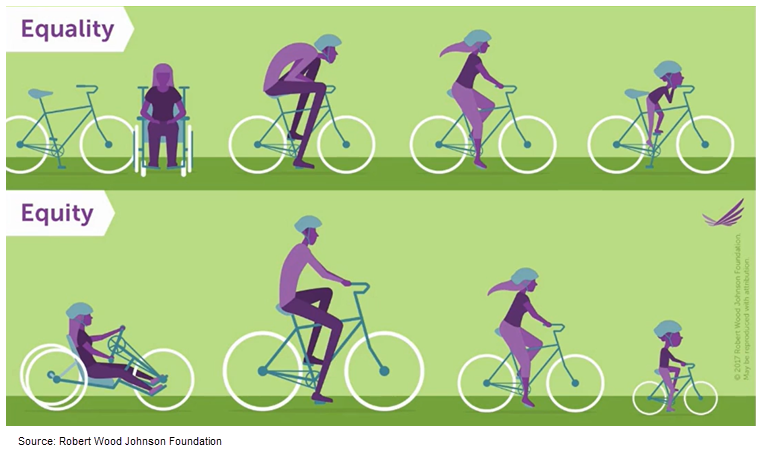
At the E Source Forum 2020, we had the honor of having DeAndrea Newman Salvador, founder and CEO of the Renewable Energy Transition Initiative, as our opening keynote speaker. She began with an important question for the utility attendees who tuned in virtually from their homes: What can you do in your roles to create a future that’s more just and equitable?
According to Salvador, collaboration is the key to enabling utilities to be a force for positive change. In her keynote “Lives and livelihoods on the line—Utilities’ opportunities as a force for positive change,” she shed light on a crisis within communities across the US. Hiding in the shadows lurks a problem that needs addressing: high energy burden.
But before we can address it, we must understand what it means. A consumer has a high energy burden if they spend more than 6% of their income on energy bills. In the US, a quarter of households have a high energy burden. That’s a frighteningly large number of customers who struggle to pay for electricity or natural gas in their homes. Every day, people are deciding whether their priority is to turn on the heat or purchase groceries to feed their family.
High energy burdens affect a variety of people, including people of color, the elderly, and people living with a disability. Children are also strongly affected because their parents are deciding whether to pay the utility bill or purchase school supplies, medications, or clothing. It makes you wonder: How is it possible that in this day and age, people have to make such choices as “heat or eat”?
In the US, 70 million households struggle to meet their basic household energy needs. It’s not just the cost of energy itself, either. Many homes are energy inefficient due to old appliances, lack of insulation, and more. Homeowners may not be able to afford to make the necessary improvements, and renters are helpless if their property owners aren’t willing to put in the time and effort or spend the money.
Salvador was frank, declaring that there’s absolutely no excuse for this reality. She said, “Access to affordable energy is and should be a basic human right. It’s not a luxury. It’s an absolute necessity.” She couldn’t be more accurate, especially when there are tangible ways for us to work together to make a difference.
She went on to acknowledge the challenges that a year like 2020 brought us as a community, calling it a “year of reckoning.” With the COVID-19 pandemic, the tense political climate, the threat to Black communities, and record-breaking weather events, many felt hopeless and overwhelmed as they watched it all unfold.
But difficult times bring opportunity, and Salvador pointed out how utilities across the country have the power and chance to make a true long-lasting impact right now. She proposed, “In our most difficult times, we are presented with opportunities to rethink our society, our markets, products, and approaches. … What can we do to create a future that is more just, more equitable than we’ve seen and experienced before?”
What’s the solution to eliminating high energy burdens?
There are many programs in place that are a good start but won’t be successful long term. Bill-savings programs—like those that allow customers to prepay for energy or pay a fixed amount each month–are beneficial but don’t necessarily guarantee to lift the burden. Low-income energy assistance and weatherization assistance programs are also fantastic because they help customers make their homes more energy efficient, but they also come with a caveat. Only a lucky few benefit from them because these kinds of programs are extremely underfunded.
Salvador wants utilities to move away from programs that serve only some groups while alienating others. It’s time we think about equity instead of equality and develop programs that use new ideas, thrilling technologies, and innovative strategies for saving energy (figure 1). In her keynote, Salvador reminded us, “We have to understand that people are not starting from the same place. Therefore, we cannot assume that they need the same solutions.”
Figure 1: Equity versus equality
How do we achieve equity in the energy sector?
“Utilities of the future will face changing demographics, circumstances, and needs,” Salvador explained. “But this also presents tremendous opportunities for change.” To fight against high energy burdens with equity in mind, Salvador suggested three steps utilities can take:
- Identify opportunities for collaboration and be open to them
- Provide education to the community to empower others
- Make clean technology solutions accessible to all
In practice, these steps can take many forms. Utilities that are committed to bettering the futures of customers who are struggling with a high energy burden should:
- Reduce demand and match it with generation that doesn’t pollute or doesn’t disproportionately pollute Black and brown communities. By doing this, utilities also address climate in addition to related health impacts.
- Support clean jobs to advance a more resilient infrastructure.
- Increase access to clean energy and energy efficiency.
The last point is critical and can be accomplished in a variety of ways. One way is to provide education to customers. Give them access to information that’s approachable and easy to comprehend. Be empathetic and use language that they can understand. Another way is to pilot and install new technologies. Give the whole community access to new and exciting energy-saving options such as rooftop solar or smart home equipment that will make them feel empowered and safe. Lastly—probably the most effective but time-consuming way—advocate for legislation that addresses energy insecurity.
The benefits of these and other collaborative strategies will go far in your community and will, in time, reduce the percentage of customers who struggle with a high energy burden. Someday, if we continue to work together, we may even start to see high energy burdens disappear altogether. If your utility needs help designing programs and services that address energy equity in your territory, send us an email.
